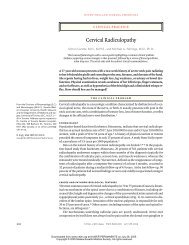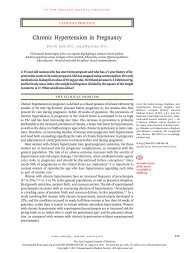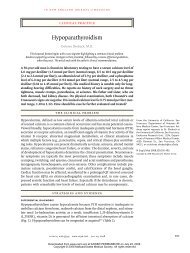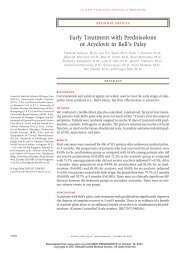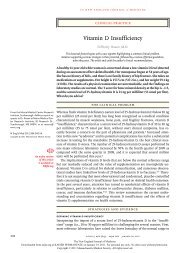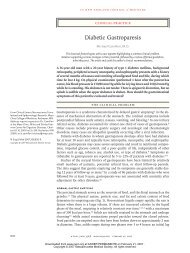Oncologic emergencies for the internist - Cleveland Clinic Journal of ...
Oncologic emergencies for the internist - Cleveland Clinic Journal of ...
Oncologic emergencies for the internist - Cleveland Clinic Journal of ...
You also want an ePaper? Increase the reach of your titles
YUMPU automatically turns print PDFs into web optimized ePapers that Google loves.
ONCOLOGIC EMERGENCIESKRIMSKY AND COLLEAGUESHyperkalemia is<strong>the</strong> most lifethreateningproblem intumor lysissyndromeNot available <strong>for</strong>online publication.See print version <strong>of</strong> <strong>the</strong><strong>Cleveland</strong> <strong>Clinic</strong> <strong>Journal</strong><strong>of</strong> MedicineFeatures <strong>of</strong> tumor lysis syndromeHyperuricemia. Catabolism <strong>of</strong> largeamounts <strong>of</strong> both RNA and DNA causes uricacid levels to rise fairly quickly. Normally, uricacid remains in <strong>the</strong> ionized state in <strong>the</strong> body;however, increased levels can lead to urateprecipitation in <strong>the</strong> distal tubule. 3 The result<strong>of</strong> precipitation is an overall decrease in renalfunction.Hyperphosphatemia and hypocalcemiaalso result from <strong>the</strong> above process. Phosphatelevels in neoplastic cells can be as much as fourtimes higher than in normal cells. 4,5 Thebreakdown and release <strong>of</strong> phosphate is initiallycompensated <strong>for</strong> by increased renal excretion.However, as <strong>the</strong> concentration <strong>of</strong> phosphateincreases, it combines with calcium and precipitatesin <strong>the</strong> renal tubule as well as in <strong>the</strong>s<strong>of</strong>t tissues. Consequently, hypocalcemia andrenal failure develop. 6 <strong>Clinic</strong>ally, hypocalcemiacan manifest as agitation, tetany, andbone pain.Hyperkalemia is perhaps <strong>the</strong> most lifethreateningderangement in tumor lysis syndrome.The sudden increase in potassiumresults in <strong>the</strong> well-defined clinical presentation<strong>of</strong> cardiac arrhythmias and death.All <strong>the</strong> above metabolic derangements aremade worse by preexisting renal insufficiency.Treatment <strong>of</strong> tumor lysis syndromeProphylaxis is <strong>the</strong> first step in treatment (TABLE2). 7 If a patient is found to be at high risk <strong>for</strong>tumor lysis syndrome, he or she shouldpromptly be started on both intravenous fluidand allopurinol if <strong>the</strong>re is no contraindicationto it. Close observation during <strong>the</strong>rapy is alsoessential, as transient, urgent hemodialysismay reverse <strong>the</strong> toxicity.■ HYPERCALCEMIA OF MALIGNANCYHypercalcemia <strong>of</strong> malignancy occurs inapproximately 10% to 20% <strong>of</strong> cancerpatients, 8,9 most <strong>of</strong>ten with lung cancer,breast cancer, and <strong>the</strong> hematologic malignanciessuch as multiple myeloma and lymphoma.10Features <strong>of</strong> hypercalcemia <strong>of</strong> malignancySymptoms vary depending on <strong>the</strong> degree <strong>of</strong>hypercalcemia and how quickly it develops.Acute symptoms include nausea, vomiting,constipation, polyuria, polydipsia, muscleweakness, acute renal insufficiency, and mentalstatus changes. Chronic symptoms includekidney stones, bone pain, and depression.Mechanisms <strong>of</strong> hypercalcemia<strong>of</strong> malignancyNormally, calcium levels are maintained by<strong>the</strong> interaction <strong>of</strong> parathyroid hormone, calcitonin,and 1,25(OH) 2 -vitamin D. The disorders<strong>of</strong> calcium metabolism in malignancyusually represent an alteration in one <strong>of</strong> <strong>the</strong>sepathways or extensive lytic bone lesions.Parathyroid hormone-related peptide.The most common cause <strong>of</strong> hypercalcemia <strong>of</strong>malignancy, classically seen in squamous celllung cancer, is a syndrome mediated by production<strong>of</strong> a parathyroid hormone-related peptide(PTHrP). Structurally similar to PTH at<strong>the</strong> amino acid terminus, PTHrP binds toparathyroid hormone receptors, mobilizes calciumfrom bones, and increases renal reabsorption<strong>of</strong> calcium. Evidence suggests that<strong>the</strong>re might be some clinical utility to measuringPTHrP because significant elevations <strong>of</strong>PTHrP seem to correlate with poorer outcomes.11–13Abnormal production <strong>of</strong> calcitriol (1,25-vitamin D). The deregulated conversion <strong>of</strong>210 CLEVELAND CLINIC JOURNAL OF MEDICINE VOLUME 69 • NUMBER 3 MARCH 2002





